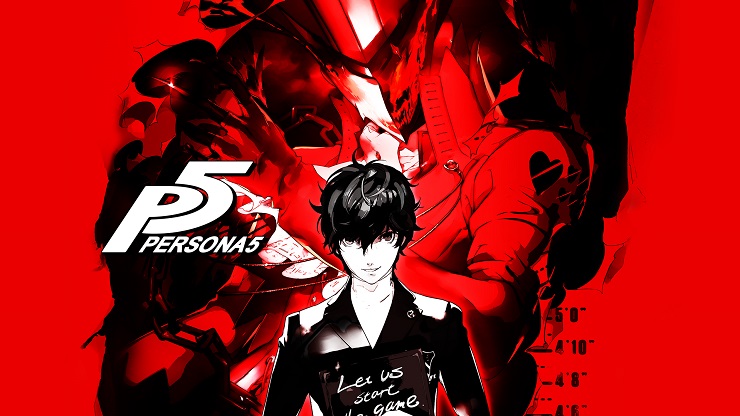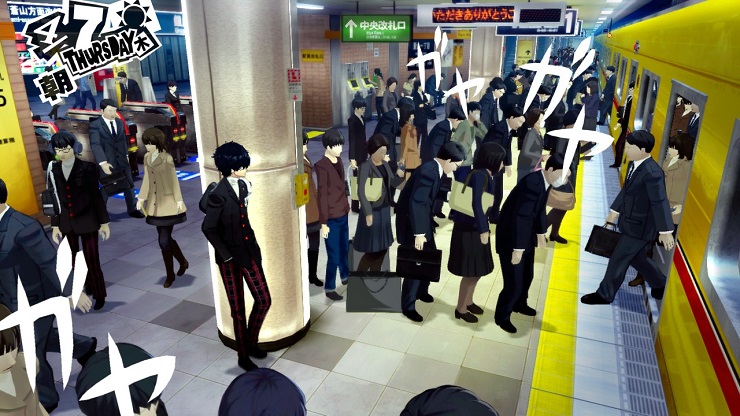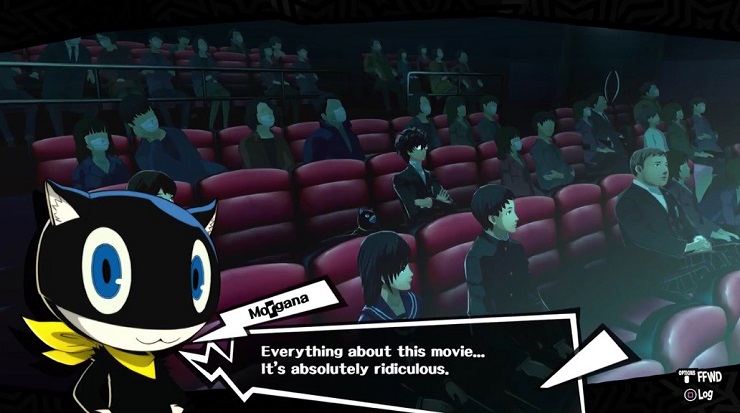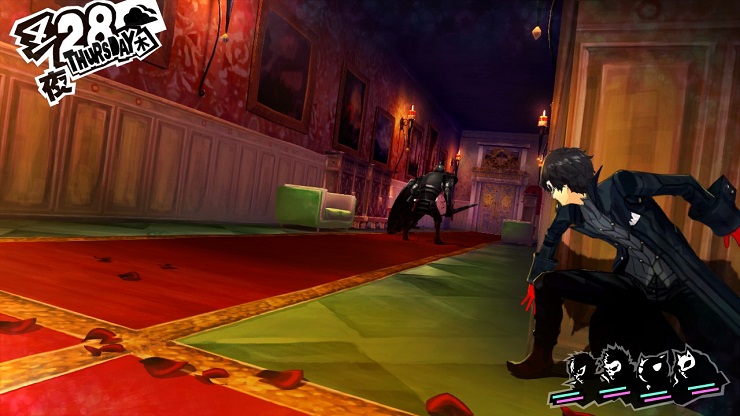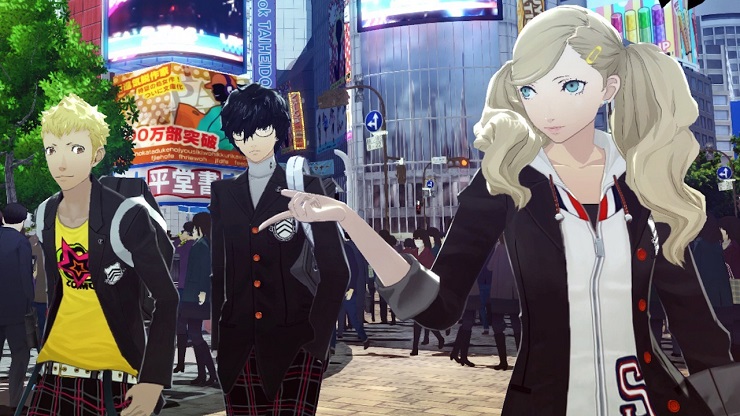April 4, 2017.
Having skipped the last home console generation aside from the lovely Catherine, Atlus is back with Persona 5 on both PlayStation 4 and PlayStation 3. Being the sixth main numbered entry in the Persona series, not only is Persona 5 accessible to newcomers but there’s so much to love for fans of both mainline Persona and mainline Shin Megami Tensei games here. I’ve put in more than 130 hours across one main play-through and a bit of messing around with previous saves, and none of that was even remotely not amazing. The developers at Atlus have outdone themselves in every way with this JRPG masterpiece.
Instead of being restricted to a more rural setting like in Persona 4, you have the big city of Tokyo and various districts within at your disposal. Many are unlocked through story segments and side activities. Safe to say, the busy streets of Tokyo through the likes of Akihabara and Shibuya are super fun to explore with the strikingly gorgeous art style displayed here. You play as a high school student, but there’s a twist. You’re actually serving probation in a new city and in a new high school after a tiff with the law previously. This is even reflected into the Velvet Room that is a place that exists between dreams and reality. You serve as an inmate in a prison with Caroline and Justine serving as wardens with Igor calling the shots. After Persona Q, it is great to see Igor back.
Given how this is a singleplayer experience and the story plays a major part in the experience, I’m not going to spoil anything. While the plot in previous entries has been mature, the overall feel has sort of evened things out. Not only are things taken a step further thematically here, but the way the story and overarching narrative come together really impressed me. You get to see how success and failure change certain characters you thought you knew well and how things like suicide and abuse change others. There are no punches pulled and it is impressive to see certain sensitive subjects dealt with such care here. There’s a sense of community created with the members of the Phantom Thieves (your party and friends) who all feel like outcasts in society or from their own families. I really enjoyed the presentation of the story in a very unorthodox manner initially. Things of course all make sense later on. There are multiple endings and the true ending is a perfect conclusion to the tale of the Phantom Thieves. I’d also recommend not checking out YouTube or even hashtags related to the game to avoid spoilers for characters and the endings.
Persona 5 still follows the calendar system as with the previous two entries so there’s an element of time management thrown into the fray. A normal day in the life of the protagonist involves taking the train to Shujin Academy, sitting through class, and then deciding what to do with his free time. Free time here feels like a much scarcer resource just because there are tons of activities for you to enjoy. Activities are useful for raising your personal traits that are in turn useful for allowing you to talk to certain people. You have the option of visiting two kinds of dungeons as well.
The main story dungeons here are very different. Instead of being procedurally generated and revolving around a certain party member as in Persona 4, you have meticulously crafted dungeons with their own gimmicks that ooze style. These are called Palaces. Palaces exist for certain people because of their own desires or nature. Palaces are alternate reality versions of real life locations that are full of enemies, traps, puzzles, and more. The goal is to steal the treasure at the end of the palace and change the heart of the person whose palace the party is in. Combat is thankfully still turn based, but it is supercharged. More on that in a bit. There’s a new stealth mechanic and don’t let the name turn you off. It is just a way of quickly navigating from different cover locations as you try and ambush your foe. This ensures you have the upper hand and can act first in combat. I’ve had a blast playing through each dungeon thanks to the unique visuals, enemies, and mechanics at play.
While the story Palaces are not random, there’s another dungeon that is the collective psyche of not a single person but multiple people. This is a randomly generated dungeon with floors going down instead of up. It can be compared to Tartarus from Persona 3. This isn’t an essential dungeon, but it is basically a means for you to take a break from the school life and social aspect of the game to do a bit of dungeon crawling, gain experience, some new Personas, and even complete side quests for items. Each dungeon also has many locked chests and an alert meter. You need lockpicks to open the aforementioned chests and can craft them using items dropped from shadows. The alert meter should be kept low because when it reaches 100% you will be sent away from the palace for the day. Early on there are story segments that require heading back to the real world before jumping back into a palace and also the fact that SP restoring items are few and far in between in the opening sections.
While many studios are dropping turn based combat for a more action oriented style in their games, Atlus stuck to their guns and improved Persona’s combat with elements from older games and even mainline Shin Megami Tensei ones. Instead of plowing through menus to choose skills, there’s a new face button system that speeds things up and lets you stylishly destroy the enemies. Gun as a mechanic is back and party members have limited ammo and different kinds of guns that are super useful against some enemies. If you target an enemy’s weakness (this is strongly encouraged once you know it), you get another turn. If you get all the enemies down through critical hits or weakness exploitation, Hold Up takes place. This lets you either execute an all out attack that will usually end the battle with a stylish conclusion screen or talk. The normal difficulty is a bit higher than what it was in Persona 4 and 3 for sure, though. But thankfully there aren’t any difficulty spikes and you don’t really need to grind unless you’re after some specific trophies.
Talk in Persona 5 is demon negotiation in Shin Megami Tensei games and it is one of the only ways to get more Persona masks for the protagonist. I’ve grown to love this over the last few Shin Megami Tensei games I’ve played. Each shadow has a unique personality and how you respond to them will determine whether they give you their power or go back to attacking you. Experimenting with new party members is always useful as they have their individual affinities and weaknesses.
Speaking of party members, I adore most of the Persona 3 and 4 casts. Just having Never More play on shuffle will remind me of my time spent playing Persona 4 and the memories with Chie, Yukiko, etc. I’ve really grown to love every character here. Makoto and Yusuke in particular are my favourites from this cast and it is good to see more than just shoehorned characters to fill up anime tropes. My only complaint about the characters is how given game progression, you spend less time with the ones who join your party and the Phantom Thieves later on. Even the NPCs are really interesting and I wish I could’ve gotten 100% with cooperations in my first playthrough. Social Links are now called cooperations and they let you spend time with another character to learn more about them, and this lets you get closer to them resulting in bonuses in combat, or in various dungeon mechanics in addition to personal stat boosts. My favourite cooperations were with the nurse at the clinic, Takemi, and one of your high school teachers, Kawakami in addition to Ann and Makoto from the main party. As of now Morgana has annoyed me as much as Teddie did in Persona 4, but I love them both.
The city of Tokyo is your oyster so to speak and you can do everything from renting a DVD to working at a flower shop, or even fishing and then attempting a Man vs Food esque burger challenge. Each of these activities gives your knowledge, charm, proficiency, kindness, or courage as a boost. Some cooperations don’t even begin until you’ve mustered up enough charm or courage. Activities like studying gives you knowledge, but studying in a diner while its raining will give you some courage as well. After conquering the Beef Bowl in Aiya from Persona 4 Golden, I knew the Big Bang Burger challenge was something I needed to complete quickly. The Vox Populi system from Persona 4 Golden returns as the Thieves Guild here. Tapping the touchpad on the controller will bring up activities others engaged in on that particular day. This is useful if you’re ever stuck or just looking for a suggestion on what to do in your free time. I love it when the smaller quality of life enhancements from previous entries are not discarded in new games.
There are some personal milestones I have in Persona games. The food challenge is one and fusing certain Personas is another. Fusing happens in the Velvet Room. You can visit the Velvet Room from various locations in the city and not just the entrance to palaces or Mementos. Fusing is absolutely essential to make any real progress against shadows in dungeons because most of the base Personas are quite weak. Fusing Jack Frost early on and then spending a good amount of time fusing various Personas to finally fuse Mara felt great. It isn’t a Persona or SMT game for me until I’ve fused Jack Frost at least.
When I first played Persona 4 Golden, I dropped it in a few hours like I did with a lot of games back then, but the music stuck with me. I ended up going back to it and binge playing it over a week just because the music was so good. Shoji Meguro’s composition and Lyn Inaizumi’s vocals have somehow managed to create a soundtrack that is nearing the top of my greatest soundtracks ever list. The acid jazz has elements heard in the score in Catherine and influences from Meguro’s older Digital Devil Saga work. Each Palace theme is perfect for the story segment and the smaller things like music in the weapon shop and the tune that plays during exams or tests are superbly done. The battle theme in particular never gets old even after a hundred hours. ‘Life Will Change’ and ‘Beneath the Mask’ are my favourite songs here. I’d rather not mention where they appear in game to avoid spoilers. The elegance of the music extends to the sound effects. Even each person’s phone ringtone is nice and subtle. I’ve only played about 40 hours of the Japanese release so haven’t heard every character’s Japanese voice but the English voice acting is mostly great. I have a problem with a certain party member’s voice annoying me enough to make me not use said member in combat. The protagonist and Morgana are absolutely perfect.
One of the first things that caught anyone’s eye for Persona 5 was the stylish menu system. I haven’t played a game that even approaches the style on display here. This isn’t limited to just the menus during combat or in the in game shops. The results screen, transitions into combat, and even loading screens are stunning. I love the small touch in the loading screen that reflected the school trip location as well. The colour of choice in P5 is most definitely red. This is seen across the game and everything is so tastefully displayed. This is an elegant and grown up Persona game that hasn’t let go of its own ideals. Even the arcana cards for each cooperation look great. There’s no point where the developers have compromised on their style. It is a pity that screenshots are blocked for most of the game. I’ve ended up with like 500 photos taken on my phone instead.
Two small things have annoyed me though. There are a lot of items in the background across the city and inside locations that are low resolution. This is a stark contrast to the gorgeousness on display everywhere else. A poster with text that looks blurry is an eyesore compared to the stylishly animated faceless NPCs walking around the meticulously replicated train station in game compared to real life. I’m also not a fan of the dialogue boxes when there’s three lines of text. Things get a bit cluttered since the Japanese release interface sizes had only two lines of text. I wish there was some change done here because that’s the only interface related problem I have. If there ever is an enhanced release, the story is already more or less perfect so the only additions I could see is an in game cutscene viewer or a jukebox for music. Both of these are lacking right now.
Persona 5 is a fantastic video game. It’s pacing is amazing and it never bogs you down with filler content. You can start with this one as a newcomer who is probably impressed with the menus and returning fans will enjoy everything from the slight nods to things from previous games or to the end game section that will please older fans of the franchise. Now is the best time to jump into the Persona franchise and there’s no better JRPG than this one right now. I’ve beaten Persona 5 nearly a month ago and haven’t stopped thinking about it ever since. I keep reloading old save files to revisit different areas. This one is really special.
Excellent enhanced turn based combat
Brilliantly designed dungeons
Superlative soundtrack
Great characters and a memorable story
Super stylish interface
Some low resolution art
Persona 5 is one of the best games I have had the pleasure of playing and something that managed topping my favourite game of all time Persona 4 Golden in almost every way.


